高中英语时态之现在完成时
高中英语时态用法:过去进行时和现在完成时

高中英语时态用法:过去进行时和现在完成时高中英语十六种时态用法详解之现在完成时1. 现在完成时的定义现在完成时既可表示过去发生的动作对现在所造成的结果或影响(此时通常连用的时间状语有already, yet, just, ever, before),也可表示动作从过去某时间开始,一直持续到现在,并且还有可能持续下去(此时通常连用的时间状语有this month / week / year, these days, recently / lately, in the past few + 时间段, since +时间点, for + 时间段)。
如:I have just finished my work. 我把工作做完。
Have you ever been to Beijing? 你曾经去过北京吗?I have lived for ten years. 我在这儿住了十年了。
We have studied here since 2003. 我们自2003年来就在这儿读书了。
2. 现在完成时的结构现在完成时由“have / has + 过去分词”构成。
3. 现在完成时的应用(1) 非持续性动词go, come, leave, borrow, buy, die, join的完成时的肯定式不能与时间段连用,若要接用时间段状语,则应换成相应的持续动词或状态动词。
如:He has left. 他走了。
He has been away for an hour. 他走了一个小时了。
Can I borrow that book? 我可以借那本书吗?How long can I keep the book? 这本书我可借多久?注意:非持续性动词的否定完成时可与时间段状语连用。
如:He has not borrowed the book since then. 从此以后,他再也没有借这本书了。
(2) have / has been to 表示曾经去过某地,但现在不在那儿;have / has gone to表示现在已去某地,现在不在这儿。
高中英语时态用法:过去进行时和现在完成时

高中英语时态用法:过去进行时和现在完成时高中英语时间是语法,需要学生掌握以理解英语的语法和表达方式。
过去进行时和现在完成时是高中英语中的两个时态,这两个时态虽然使用的时间不同,但是在思维和表达方式上有很多相似之处。
在这篇文章中,我将深入探讨这两个时态的用法和区别。
一、过去进行时过去进行时表示在过去某个时间正在进行的动作或者状态。
它通常有两个或者三个部分。
第一个部分是过去式的“be”动词,第二个部分是动词的现在分词形式,第三个部分是表示时间的状语。
例如:1. I was studying English when my friend called me. (我正在学英语时,我的朋友打电话给我。
)2. The children were playing in the park when it started to rain. (孩子们正在公园里玩耍,这时下起了雨。
)尽管过去进行时的结构看起来很简单,但是正确地使用它需要考虑下列几个要素:1. 过去进行时通常与过去的时间连用,比如“yesterday,”last week,”或者“at that time”。
例如:I was cookin g dinner at 8 o’clock last night. (昨晚8点我在做晚饭。
)2. 过去进行时的肯定形式使用“was/were+现在分词”,而否定形式使用“was/were not+现在分词”。
3. 过去进行时通常用于描述两个同时进行的动作。
比如:I was working on my report while she was watching TV. (我在写报告,她在看电视。
)二、现在完成时现在完成时用于表示前不久发生的动作或者状态跟现在的影响或者结果。
它的基本形式是“have/has+动词的过去分词形式”。
例如:1. I have finished my homework. (我已经完成作业。
)2. She has lived in Canada for five years. (她已经在加拿大生活了五年。
高中英语时态总结
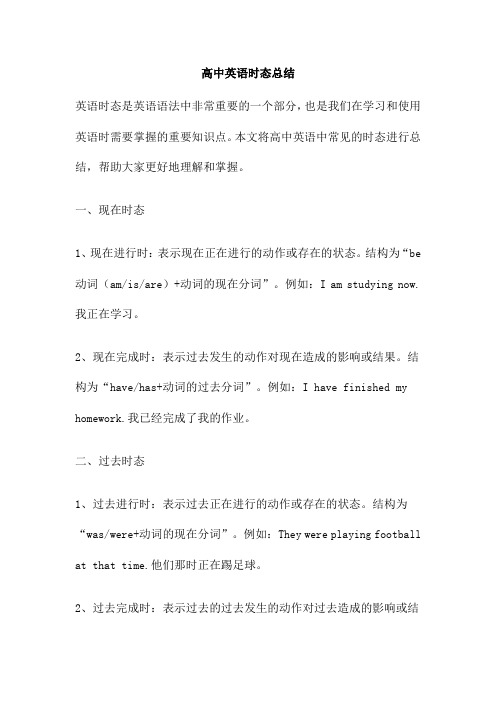
高中英语时态总结英语时态是英语语法中非常重要的一个部分,也是我们在学习和使用英语时需要掌握的重要知识点。
本文将高中英语中常见的时态进行总结,帮助大家更好地理解和掌握。
一、现在时态1、现在进行时:表示现在正在进行的动作或存在的状态。
结构为“be 动词(am/is/are)+动词的现在分词”。
例如:I am studying now.我正在学习。
2、现在完成时:表示过去发生的动作对现在造成的影响或结果。
结构为“have/has+动词的过去分词”。
例如:I have finished my homework.我已经完成了我的作业。
二、过去时态1、过去进行时:表示过去正在进行的动作或存在的状态。
结构为“was/were+动词的现在分词”。
例如:They were playing football at that time.他们那时正在踢足球。
2、过去完成时:表示过去的过去发生的动作对过去造成的影响或结果。
结构为“had+动词的过去分词”。
例如:They had finished their work before we arrived.他们在我们到达之前已经完成了他们的工作。
三、将来时态1、将来进行时:表示将来某个时间正在进行的动作或存在的状态。
结构为“will+be动词+动词的现在分词”。
例如:I will be studying at 9 o’clock tomorrow.我明天9点将会在学习。
2、将来完成时:表示将来某个时间已经完成的动作或达到的状态。
结构为“will+have+动词的过去分词”。
例如:I will have finished my homework by 10 o’clock tonight.我将在今晚10点之前完成我的作业。
以上是高中英语中常见的时态总结,希望能够帮助大家更好地理解和掌握英语时态。
需要注意的是,不同的时态有着不同的用法和结构,大家在使用时需要根据语境选择合适的时态。
高中生英语必备16种时态

时态(Tense)是表示行为、动作和状态在各种时间条件下的动词形式。
因此,当我们说时态结构的时候,指的是相应时态下的动词形式。
英语时态分为16种:一般现在、一般过去、一般将来、过去将来时,以及这四者的进行时、完成时和完成进行时。
下面是16种时态的谓语动词形式和具体用法,高考必考的是前十个时态,同学们需要重点掌握。
1.一般现在时(do/does; is/am/are)①表示现在的情况、状态或特征。
例:He is a student.他是一个学生。
②表示经常性、习惯性动作。
例:He always helps others.他总是帮助别人。
③客观事实和普遍真理。
例:The earth moves the sun.地球绕着太阳转。
④表示一个按规定、计划或安排要发生的动作。
仅限于某些表示“来、去、动、停、开始、结束、继续”等的动词,可以与表示未来时间的状语搭配使用。
常见的用法是:飞机、火车、轮船、汽车等定期定点运行的交通方式。
例:The next train leaves at 3 o'clock this afternoon.下一趟火车今天下午3点开车。
⑤在时间、条件和让步状语从句中经常用一般现在(有时也用现在完成时)表示将的来事情。
(即:主将从现原则)例:I will call you as soon as I arrive at the airport.我一到机场就会给你打电话。
When you have finished the report, I will have waited for about 3 hours.等你完成这份报告的时候,我就已经等了将近3个小时了。
2. 现在进行时(am/is/are doing)①表示此时此刻正在发生的事情。
例:He is listening to the music now.他现在正在听音乐。
②表示目前一段时间内一直在做的事情,但不一定此时此刻正在做。
现在完成时——高考英语重点时态语态满分攻略
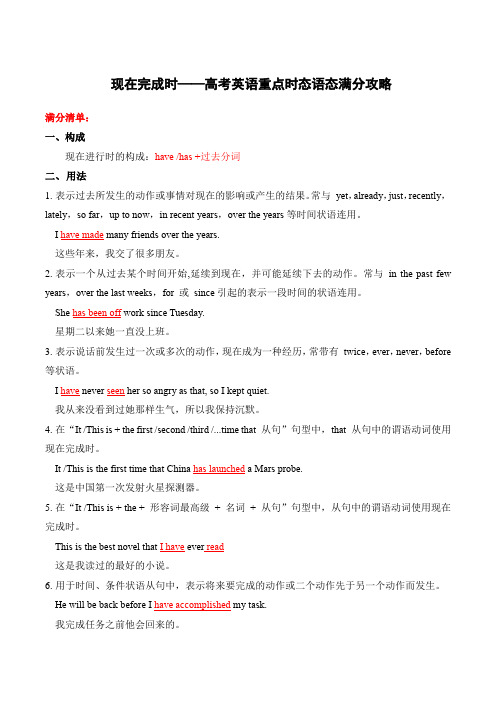
现在完成时——高考英语重点时态语态满分攻略满分清单:一、构成现在进行时的构成:have /has +过去分词二、用法1.表示过去所发生的动作或事情对现在的影响或产生的结果。
常与yet,already,just,recently,lately,so far,up to now,in recent years,over the years等时间状语连用。
I have made many friends over the years.这些年来,我交了很多朋友。
2.表示一个从过去某个时间开始,延续到现在,并可能延续下去的动作。
常与in the past few years,over the last weeks,for 或since引起的表示一段时间的状语连用。
She has been off work since Tuesday.星期二以来她一直没上班。
3.表示说话前发生过一次或多次的动作,现在成为一种经历,常带有twice,ever,never,before 等状语。
I have never seen her so angry as that, so I kept quiet.我从来没看到过她那样生气,所以我保持沉默。
4.在“It /This is + the first /second /third /...time that 从句”句型中,that 从句中的谓语动词使用现在完成时。
It /This is the first time that China has launched a Mars probe.这是中国第一次发射火星探测器。
5.在“It /This is + the + 形容词最高级+ 名词+ 从句”句型中,从句中的谓语动词使用现在完成时。
This is the best novel that I have ever read这是我读过的最好的小说。
6.用于时间、条件状语从句中,表示将来要完成的动作或二个动作先于另一个动作而发生。
英语现在完成时讲解

英语现在完成时讲解英语中的现在完成时(present perfect tense)是用来描述过去发生的动作或情况与现在的关系的一种时态。
它通常用来强调过去发生的事情对现在产生的影响或结果。
在本文中,我们将详细讨论现在完成时的使用情况及其构成方式。
一、现在完成时的构成方式现在完成时的构成方式是由“助动词have/has + 动词的过去分词形式”组成。
具体使用有以下几种情况:1. 肯定句主语 + have/has + 过去分词 + 其他部分例如:- I have studied English for five years.(我已经学习英语五年了。
)- She has travelled to many countries.(她已经去过很多国家了。
)2. 否定句主语 + have/has + not + 过去分词 + 其他部分例如:- He hasn't finished his work yet.(他还没有完成工作。
)- We haven't seen each other for a long time.(我们已经很久没有见面了。
)3. 疑问句Have/Has + 主语 + 过去分词 + 其他部分?例如:- Have you ever visited Paris?(你曾经去过巴黎吗?)- Has she seen the latest movie?(她看过最新的电影吗?)二、现在完成时的使用情况现在完成时通常用于以下几种情况:1. 表示过去开始的动作一直延续至今或刚刚结束的情况。
例如:- I have lived in this city for ten years.(我在这个城市已经住了十年了。
)- They have worked on this project since last month.(他们从上个月开始就一直在做这个项目。
)2. 表示过去发生的动作对现在产生的影响或结果。
高中英语时态归纳
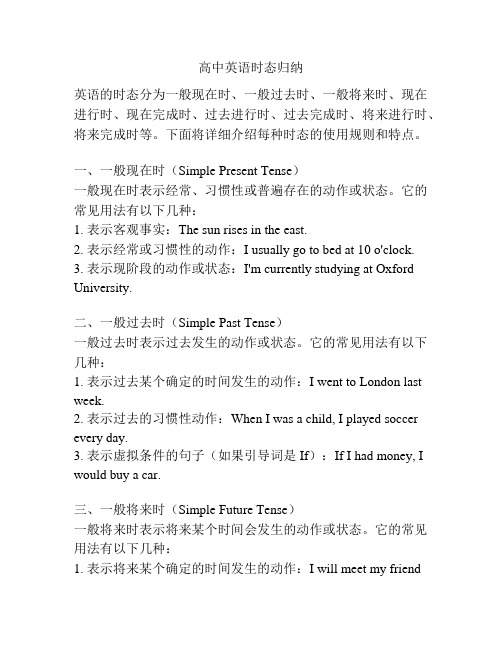
高中英语时态归纳英语的时态分为一般现在时、一般过去时、一般将来时、现在进行时、现在完成时、过去进行时、过去完成时、将来进行时、将来完成时等。
下面将详细介绍每种时态的使用规则和特点。
一、一般现在时(Simple Present Tense)一般现在时表示经常、习惯性或普遍存在的动作或状态。
它的常见用法有以下几种:1. 表示客观事实:The sun rises in the east.2. 表示经常或习惯性的动作:I usually go to bed at 10 o'clock.3. 表示现阶段的动作或状态:I'm currently studying at Oxford University.二、一般过去时(Simple Past Tense)一般过去时表示过去发生的动作或状态。
它的常见用法有以下几种:1. 表示过去某个确定的时间发生的动作:I went to London last week.2. 表示过去的习惯性动作:When I was a child, I played soccer every day.3. 表示虚拟条件的句子(如果引导词是If):If I had money, I would buy a car.三、一般将来时(Simple Future Tense)一般将来时表示将来某个时间会发生的动作或状态。
它的常见用法有以下几种:1. 表示将来某个确定的时间发生的动作:I will meet my friendtomorrow.2. 表示未来的预测、打算或意愿:I hope she will come to the concert.3. 表示对某个事件的推测或猜测:I think it will rain later.四、现在进行时(Present Continuous Tense)现在进行时表示现在正在进行的动作。
它的常见用法有以下几种:1. 表示现在进行的动作:I am studying English at the moment.2. 表示现阶段的习惯性动作:He is always complaining about his job.五、现在完成时(Present Perfect Tense)现在完成时表示过去发生的动作对现在造成的影响或状态,或者表示过去发生的动作具有的持续性。
(完整)高中英语语法之现在完成时

现在完成时讲解一、基本结构:主语+have/has+过去分词(done)①肯定句:主语+have/has+过去分词+其他②否定句:主语+have/has+not+过去分词+其他③一般疑问句:Have/Has+主语+过去分词+其他④特殊疑问句:特殊疑问词+一般疑问句(have/has+主语+过去分词+其他)二、用法1)现在完成时的"完成用法"现在完成时用来表示现在之前已发生过或完成的动作或状态,但其结果却和现在有联系,也就是说,动作或状态发生在过去但它的影响现在还存在.He has turned off the light.他已把灯关了。
(动作结束于过去,但说明的是现在的情况--灯现在不亮了。
)I have spent all of my money.(含义是:现在我没有钱花了.)Jane has laid the table.(含义是:现在桌子已经摆好了.)2)现在完成时的"未完成用法"指的是动作开始于过去某一时刻,一直延续到现在,或可能还要继续下去。
这里的动词要用持续性动词。
常与for (+时间段),since(+时间点)连用.Mary has been ill for three days.Mary has been ill since three days ago.注意:1.现在完成时不能单独与准确时间连用,(如表示过去的时间状语)如yesterday(morning、afternoon),last(morning、afternoon)等,除非与for, since连用.2.现在完成时往往同表示不确定的过去时间状语连用,如already(肯定), yet(否定,疑问), just, before, recently, still, latel y等:He has already obtained a scholarship.I haven't seen much of him recently (lately).We have seen that film before.Have they found the missing child yet ?3. 现在完成时常常与表示频度的时间状语连用,如ever, never, twice, several times等:Have you ever been to BeijingI have never heard Bunny say anything against her.I have used this pen only three times. It is still good.George has met that gentleman several times.4. 现在完成时还往往可以同包括现在时间在内的时间状语连用,如up to these few days/weeks/months/years, just, up to present(now), so far等:Peter has written six papers so far.Up to the present everything has been successful.5. 现在完成时还可以用来表示过去的一个时间到现在这段时间内重复发生的动作.We have had four texts this semester.6. have been to 和have gone to的区别have been to 强调“去过”,现已不在那里,如:He has been to the USA three times.他到美国去过三次。
高中英语知识点总结:十六种时态

高中英语知识点总结:十六种时态导读:本文高中英语知识点总结:十六种时态,仅供参考,如果能帮助到您,欢迎点评和分享。
十六种时态:一般现在时,一般过去时,一般将来时,一般过去将来时;现在进行时,过去进行时,将来进行时,过去将来进行时;现在完成时,过去完成时,将来完成时,过去将来完成时;现在完成进行时,过去完成进行时,将来完成进行时,过去将来完成进行时.一、一般现在时:take形式为原形例子:It take sme five years to finish the painting。
这幅画花了我十年功夫1.概念:经常、反复发生的动作或行为及现在的某种状况。
2.时间状语:always,usually,often,sometimes,everyweek(day,year,month…), once a week,on Sundays,3.基本结构:动词原形(如主语为第三人称单数,动词上要改为第三人称单数形式)二、一般过去时:take形式为took.1.概念:过去某个时间里发生的动作或状态;过去习惯性、经常性的动作、行为。
2.时间状语:ago,yesterday,the day before yesterday,lastweek,last(year,night,month…),in1989,just now,at the age of 5,one day,long long ago,once up on a time,etc.3.基本结构:be动词;行为动词的过去式三、现在进行时:take形式为am/is/are taking1.概念:表示现阶段或说话时正在进行的动作及行为。
2.时间状语:now,at this time,these days,etc.3.基本结构:am/is/are+doing四、过去进行时:take形式为was/were+taking1.概念:表示过去某段时间或某一时刻正在发生或进行的行为或动作。
高中英语时态用法:现在完成进行时和过去完成式

高中英语时态用法:现在完成进行时和过去完成式高中英语十六种时态用法详解之现在完成进行时1. 现在完成进行时的定义现在完成进行时表示某动作从过去某个时间开始,一直延续到现在,并且还有可能持续下去。
如:We have been waiting for him for two hours. 我们等他等了两个小时。
2. 现在完成进行时的结构现在完成进行时由“have /has been + 现在分词”构成。
3. 现在完成进行时的应用现在完成进行时所用的时间状语:this month / week / year, these days, recently / lately, in the past few + 时间段, since +时间点, for + 时间段。
如:They have been building the bridge for two month. 两个月来他们一直在修桥。
They have been planting trees this month. 这个月来他们一直在植树。
4. 现在完成进行时与现在完成时的区别(1) 现在完成时强调动作的完成,而现在完成进行时强调动作的延续,因此,表示动作的完成,只能用现在完成时,而不能用现在完成进行时。
如:He has changed his idea. 他改变了想法。
(2) 在表示动作的延续时,虽然既可用现在完成时,也可用现在完成进行时,但现在完成进行时强调动作的进行。
因此在需要明确表示动作还要持续下去时,应用现在完成进行时。
如:We have been studying here for two years. 我们在这儿已经学习了两年了。
(3) 有些延续性动词(如 keep, learn, live, stay, study, work等),用于现在完成时或现在完成进行时的区别不大。
如:I have lived here for many years.=I have been living here for many years. 我在这儿住了多年了。
高中英语时态用法:过去进行时和现在完成时

高中英语时态用法:过去进行时和现在完成时高中英语时态用法:过去进行时和现在完成时在英语学习中,时态是非常重要的一个内容,有正确地理解和掌握,才能够准确地表达自己的意思并很好地与别人交流。
其中,过去进行时和现在完成时是两个非常常用的英语时态,在学习时需要格外重视。
一、过去进行时过去进行时是用来描述过去某一具体时刻或时间段内正在进行的动作的。
用法:was/were+ 现在分词。
比如:1. I was watching TV when he called me.2. When I was studying, my brother was playing games.3. They were sleeping when I entered the house.过去进行时有时也用来表示两个或多个动作同时发生,此时需要将各个动作的过去进行时连写。
比如:1. She was cooking the dinner while he was setting the table.2. We were playing games and reviewing the book at the same time.二、现在完成时现在完成时是用来描述发生在过去某一时间到现在这段时间内的动作,并强调这段时间内动作对现在造成的影响。
用法:have/has+过去分词。
比如:1. I have eaten lunch.2. She has visited New York twice.3. He has finished the project.现在完成时也可用于描述某一经验、特殊现象或重要成果等,比如:1. I have been to China many times.2. They have learned English for five years.3. We have established a new company.不过,现在完成时有时也容易与过去完成时混淆。
英语时态:现在完成时
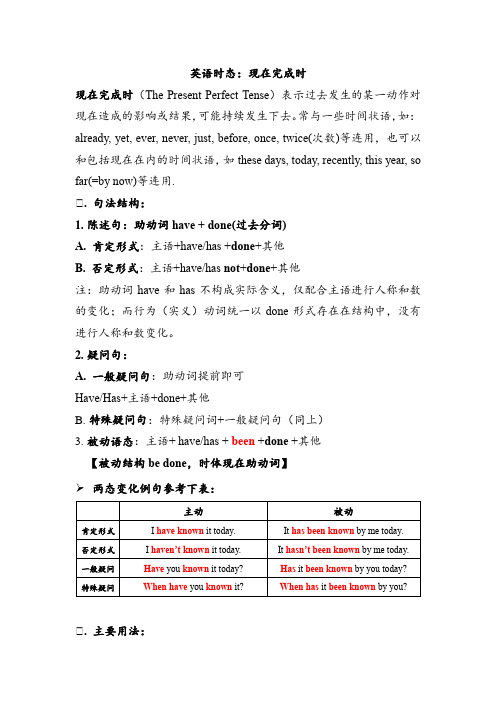
英语时态:现在完成时现在完成时(The Present Perfect Tense)表示过去发生的某一动作对现在造成的影响或结果,可能持续发生下去。
常与一些时间状语,如:already, yet, ever, never, just, before, once, twice(次数)等连用,也可以和包括现在在内的时间状语,如these days, today, recently, this year, so far(=by now)等连用.Ⅰ. 句法结构:1.陈述句:助动词have + done(过去分词)A. 肯定形式:主语+have/has +done+其他B. 否定形式:主语+have/has not+done+其他注:助动词have和has不构成实际含义,仅配合主语进行人称和数的变化;而行为(实义)动词统一以done形式存在在结构中,没有进行人称和数变化。
2.疑问句:A. 一般疑问句:助动词提前即可Have/Has+主语+done+其他B.特殊疑问句:特殊疑问词+一般疑问句(同上)3.被动语态:主语+ have/has + been +done +其他【被动结构be done,时体现在助动词】➢两态变化例句参考下表:Ⅰ. 主要用法:1.表示到说话人说话时已经完成的动作,却对现在仍有影响或结果。
He has lost his book.2.表示事情开始与过去,却一直持续到现在还在进行的事情。
He has taught in our school for 30 years.3.表示从过去某个时间直到现在的这个时间范围内不断重复发生的动作或情况,并且这个不断重复的动作有可能继续下去,也有可能到现在就结束。
My father has always gone to work by bike.4.同一般现在时可以表示将来一样,现在完成时也可以在时间状语从句里表示将来。
I’ll wait until he has written his letter.Ⅰ. 常用于现在完成时的时间状语:for, since, already, yet, ever, never, recently, just, before, so far, by now等1.for+段时间;since+(过去的某一个)点时间I have lived in Nanning for ten years.I have lived in Nanning since ten years ago.2.already用于肯定句, 可放在助动词之后、过去分词之前,也可放在句末。
高中英语语法之现在完成时

现在完成时讲解一、基本结构:主语+have/has+过去分词(done)①肯定句:主语+have/has+过去分词+其他②否定句:主语+have/has+not+过去分词+其他③一般疑问句:Have/Has+主语+过去分词+其他④特殊疑问句:特殊疑问词+一般疑问句(have/has+主语+过去分词+其他)二、用法1)现在完成时的"完成用法"现在完成时用来表示现在之前已发生过或完成的动作或状态,但其结果却和现在有联系,也就是说,动作或状态发生在过去但它的影响现在还存在.He has turned off the light.他已把灯关了。
(动作结束于过去,但说明的是现在的情况--灯现在不亮了。
)I have spent all of my money.(含义是:现在我没有钱花了.)Jane has laid the table.(含义是:现在桌子已经摆好了.)2)现在完成时的"未完成用法"指的是动作开始于过去某一时刻,一直延续到现在,或可能还要继续下去。
这里的动词要用持续性动词。
常与for (+时间段),since(+时间点)连用.Mary has been ill for three days.Mary has been ill since three days ago.注意:1.现在完成时不能单独与准确时间连用,(如表示过去的时间状语)如yesterday(morning、afternoon),last(morning、afternoon)等,除非与for, since连用.2.现在完成时往往同表示不确定的过去时间状语连用,如already(肯定), yet(否定,疑问), just, before, recently, still, latel y等:He has already obtained a scholarship.I haven't seen much of him recently (lately).We have seen that film before.Have they found the missing child yet ?3. 现在完成时常常与表示频度的时间状语连用,如ever, never, twice, several times等:Have you ever been to BeijingI have never heard Bunny say anything against her.I have used this pen only three times. It is still good.George has met that gentleman several times.4. 现在完成时还往往可以同包括现在时间在内的时间状语连用,如up to these few days/weeks/months/years, just, up to present(now), so far等:Peter has written six papers so far.Up to the present everything has been successful.5. 现在完成时还可以用来表示过去的一个时间到现在这段时间内重复发生的动作.We have had four texts this semester.6. have been to 和have gone to的区别have been to 强调“去过”,现已不在那里,如:He has been to the USA three times.他到美国去过三次。
关于高中英语的十六种英语时态详细解析
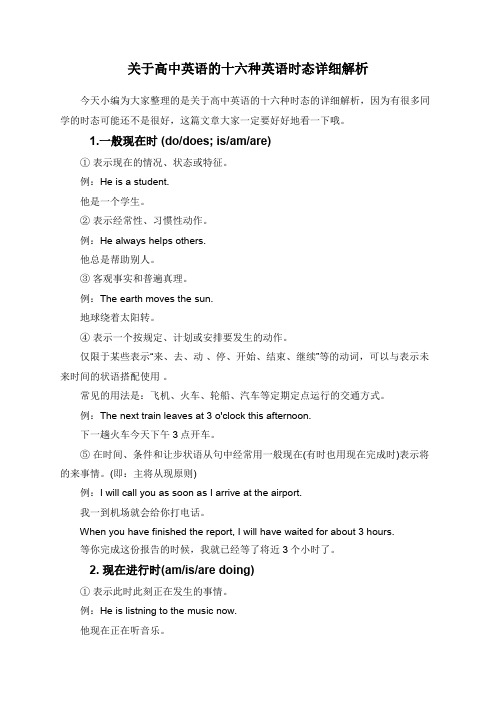
关于高中英语的十六种英语时态详细解析今天小编为大家整理的是关于高中英语的十六种时态的详细解析,因为有很多同学的时态可能还不是很好,这篇文章大家一定要好好地看一下哦。
1.一般现在时 (do/does; is/am/are)①表示现在的情况、状态或特征。
例:He is a student.他是一个学生。
②表示经常性、习惯性动作。
例:He always helps others.他总是帮助别人。
③客观事实和普遍真理。
例:The earth moves the sun.地球绕着太阳转。
④表示一个按规定、计划或安排要发生的动作。
仅限于某些表示“来、去、动、停、开始、结束、继续”等的动词,可以与表示未来时间的状语搭配使用。
常见的用法是:飞机、火车、轮船、汽车等定期定点运行的交通方式。
例:The next train leaves at 3 o'clock this afternoon.下一趟火车今天下午3点开车。
⑤在时间、条件和让步状语从句中经常用一般现在(有时也用现在完成时)表示将的来事情。
(即:主将从现原则)例:I will call you as soon as I arrive at the airport.我一到机场就会给你打电话。
When you have finished the report, I will have waited for about 3 hours.等你完成这份报告的时候,我就已经等了将近3个小时了。
2. 现在进行时(am/is/are doing)①表示此时此刻正在发生的事情。
例:He is listning to the music now.他现在正在听音乐。
②表示目前一段时间内一直在做的事情,但不一定此时此刻正在做。
例:I am studying computer this term.这个学期我一直在学习计算机。
③现在进行时可以表示将来的含义。
a. 瞬时动词的进行一定表将来。
高一英语语法(2-1):动词的时态之一般现在时、现在进行时和现在完成时

高一英语语法(2-1):动词的时态之一般现在时、现在进行时和现在完成时一、动词有4个时、4个态,一共有16个时态1. 以work为例2. 在下列数轴上标注出时态的位置1)work / works2)am / is / are working3)have / has worked二、一般现在时(work / works)、现在进行时(am / is / are working)和现在完成时(have / has worked)1.一般现在时1)表示经常发生或习惯性的动作或状态,通常与usually,often,always,sometimes,every day,once a week等时间状语连用,有时也可不加这类状语。
如:2)表示客观事实或普遍真理。
如:The earth __________ (move) around the sun. 3)按时刻表、日程表、节目单、课程表等规定将要发生的动作,也用一般现在时表示将来。
如:The plane __________ (arrive) at 8:00 and __________ (leave) at 8:30.4)在连词when,as soon as,before,until,if等引导的表示未来行为的时间或条件状语从句中,常用一般现在时代替将来时,这是英语的习惯表达法。
但he __________ (come) here, he __________ (go) to visit you.2.现在进行时1)表示此时此刻正在进行的动作。
如:They __________ (have) an English class2)表示现阶段正在进行的动作,虽然此时此刻这一动作不一定在进行。
如:The3)在时间、条件状语从句中,有时可用现在进行时代替一般将来时。
如:When you __________ (pass) my way, please drop in. (详见二-6“即将”)4)现在进行时与always,all the time,forever,constantly等副词连用,表示感叹、惊讶、赞许、厌恶等情感。
英语时态:现在完成时

现在完成时一、定义现在完成时表示过去发生的动作或状态对现在造成的影响,或过去发生的动作或状态持续到现在。
二、时间状语现在完成时常用的时间状语主要包括:✧表示过去不确定时间的状语:already,yet,just,recently,before...✧包含现在的时间状语:today,this morning/week/month/year,so far,until now,up to present...✧表示频率的时间状语:ever,never,twice...✧since+某个时间点(如since last Monday)✧since+一段时间+ago(如since two hours ago)✧for+一段时间(如for two years)三、动词形式现在完成时的谓语部分由助动词(have/has)加动词的过去分词(done)组成,主语为第一人称、第二人称、第三人称复数时助动词用have,为第三人称单数时用has。
规则动词的过去分词和过去式的构成规则相同(见下方第1-5点规则)。
动词的过去分词的构成规则主要包括:(1)一般动词,在词尾加-ed。
发音规则:在以浊辅音或元音结尾的词后发音/d/,以清辅音结尾的词后发音/t/,以t 或d结尾的词后发音/id/。
示例:ask-asked/t/climb-climbed/d/open-opened/d/pass-passed/t/want-wanted/id/need-needed/id/(2)以不发音e结尾的动词,在词尾加-d。
发音规则:在以浊辅音或元音结尾的词后发音/d/,以清辅音结尾的词后发音/t/,以t 或d结尾的词后发音/id/。
示例:arrive-arrived/d/close-closed/d/die-died/d/hope-hoped/t/decide-decided/id/(3)以辅音+y结尾的动词,y变为i再加-ed。
发音规则:发音/d/。
高中英语时态语态专题-----现在完成时讲解和练习
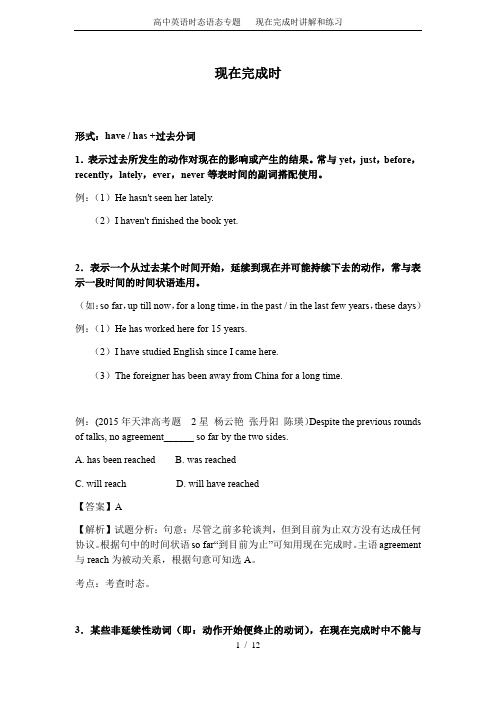
现在完成时形式:have / has +过去分词1.表示过去所发生的动作对现在的影响或产生的结果。
常与yet,just,before,recently,lately,ever,never等表时间的副词搭配使用。
例:(1)He hasn't seen her lately.(2)I haven't finished the book yet.2.表示一个从过去某个时间开始,延续到现在并可能持续下去的动作,常与表示一段时间的时间状语连用。
(如:so far,up till now,for a long time,in the past / in the last few years,these days)例:(1)He has worked here for 15 years.(2)I have studied English since I came here.(3)The foreigner has been away from China for a long time.例:(2015年天津高考题2星杨云艳张丹阳陈瑛)Despite the previous rounds of talks, no agreement______ so far by the two sides.A. has been reachedB. was reachedC. will reachD. will have reached【答案】A【解析】试题分析:句意:尽管之前多轮谈判,但到目前为止双方没有达成任何协议。
根据句中的时间状语so far“到目前为止”可知用现在完成时。
主语agreement 与reach为被动关系,根据句意可知选A。
考点:考查时态。
3.某些非延续性动词(即:动作开始便终止的动词),在现在完成时中不能与表示一段时间状语搭配。
常见的非延续动词:die, arrive,join,leave,go, refuse,fail,finish,buy,marry,divorce,awake ,buy,borrow,lend 等。
高中英语语法专题二: 英语时态语态专项讲解与练习 (含答案)
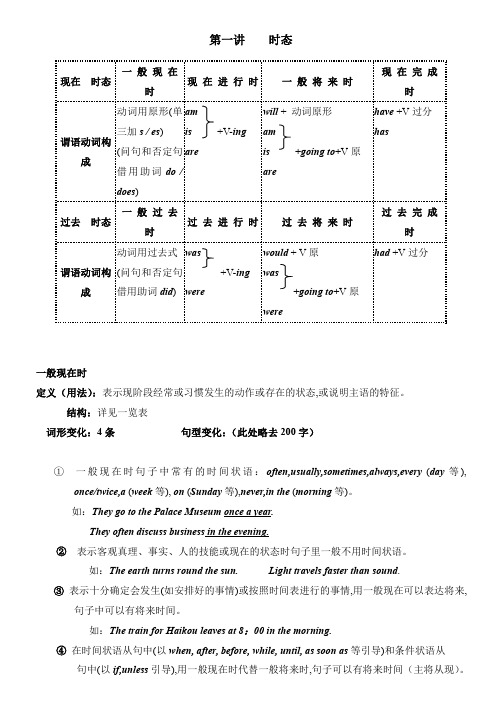
第一讲时态一般现在时定义(用法):表示现阶段经常或习惯发生的动作或存在的状态,或说明主语的特征。
结构:详见一览表词形变化:4条句型变化:(此处略去200字)①一般现在时句子中常有的时间状语:often,usually,sometimes,always,every(day等),once/twice,a(week等),on(Sunday等),never,in the(morning等)。
如:They go to the Palace Museum once a year.They often discuss business in the evening.②表示客观真理、事实、人的技能或现在的状态时句子里一般不用时间状语。
如:The earth turns round the sun.Light travels faster than sound.③表示十分确定会发生(如安排好的事情)或按照时间表进行的事情,用一般现在可以表达将来,句子中可以有将来时间。
如:The train for Haikou leaves at8:00in the morning.④在时间状语从句中(以when,after,before,while,until,as soon as等引导)和条件状语从句中(以if,unless引导),用一般现在时代替一般将来时,句子可以有将来时间(主将从现)。
如:Please ring me up as soon as you arrive in Germany.If it rains tomorrow,we will have to stay at home.一般过去时定义(用法)表示过去某时发生的动作或状态,这种动作或状态可能是一次性,也可能经常发生。
结构:详见一览表词形变化:(4条规则与不规则)句型变化:(此处略去200字)①表示过去具体时刻发生的一次性动作时,时间状语有:at(eight)(yesterdaymorning),(ten minutes)ago,when引导的时间状语从句。
- 1、下载文档前请自行甄别文档内容的完整性,平台不提供额外的编辑、内容补充、找答案等附加服务。
- 2、"仅部分预览"的文档,不可在线预览部分如存在完整性等问题,可反馈申请退款(可完整预览的文档不适用该条件!)。
- 3、如文档侵犯您的权益,请联系客服反馈,我们会尽快为您处理(人工客服工作时间:9:00-18:30)。
现在完成时1、概念:表示过去发生的对现在有影响的动作或者表示从过去持续到现在的动作或状态。
2、时间状语:already, before, ever, just, lately, never, once, recently, yet, until now, so far,in the past few years, up to the present等。
3、基本结构:have/has donehave/has done肯定句The old man has lived here for more than twenty years.否定句The old man hasn’t lived here for more than twenty years.一般疑问句Has the old man lived here for more than twenty years?特殊疑问句How long has the old man lived here?4、现在完成时的用法:1)现在完成时表示动作发生在过去,但对现在造成一定的影响:这种用法的时间状语有四类,如下:【例句】I have just finished my homework.I have seen the film three times.Up to now we have planted over 24,000 fruit trees.Great changes have taken place in the past twenty years in China.12)现在完成时表示从过去持续到现在的动作或状态:这种用法通常与由since或for引导的时间状语连用,动词需要使用延续性动词。
【例句】I haven’t been here for five years.There have been a lot of changes since 1978.She has worked as an English teacher since she left University.3)现在完成时可以用来表示过去的一个时间到现在这段时间内重复发生的动作:【例句】We have had four texts this semester.He has failed many times recently.4)have been to和have gone to的区别:①have been to强调“去过”,现在已经不在那里;②have gone to强调的是“去了”,现在还在那里或在去那里的路上。
【例句】He has been to the USA three times. (过去“去过美国”,现在已“不在美国”)--Where’s your mother?--She has gone to the hospital. (现在在医院,或者去医院的路上)另外,has been in表示“一直在某地”,如:We have been in Beijing for a whole year.5)使用现在完成时的固定句型:2后三个句型也可以用一般过去时(was),此时从句谓语动词通常用过去完成时。
如:There was a knock at the door. It was the second time someone had interrupted me that evening.二、现在完成进行时1、概念:表示动作从过去某一时间开始,一直延续到现在,可能还要继续下去。
2、时间状语:主要有①since + 时间点;②since + 从句;③for + 时间段3、基本结构:have/has been doinghave/has been doing肯定句I have been sitting here for an hour.否定句I haven’t been sitting here for an hour.一般疑问句Have you been sitting here for an hour?特殊疑问句How long have you been sitting here?4、现在完成进行时的用法:1)现在完成进行时表示从过去一直持续到现在的动作或刚刚结束的动作:【例句】I’ve been writing letters all this morning.我写了一上午信。
(动作刚刚结束,不再继续)O’Neil is ill. He’s been lying in the bed for three weeks.奥尼尔在病中,已经卧床3个星期了。
(动作会继续下去)2)现在完成进行时表示从过去到现在的重复性动作:现在完成进行时的这种用法所表示的并不是一直在进行的动作,而是断断续续地反复发生的动作。
【例句】That reporter has been contributing articles to this magazine all these years.这些年那个记者一直为这家杂志撰稿。
(断断续续地反复发生的动作)We’ve been seeing quite a lot of each other recently.最近我们经常见面。
33)现在完成进行时强调动作延续时间的长久或带感情色彩:【例句】She has always been working like that. 她一贯是这样工作的。
4)动词本身不包含持续意义,若要表示动作延续到现在,可以用现在完成进行时:【例句】They’ve been building a ship.他们一直在造一艘船。
(在进行)5、现在完成进行时与现在完成时的区别:1)现在完成进行时更强调动作的延续性,它是现在完成时的强调形式。
试比较:We’ve been living here for ten years.We’ve lived here for ten years.2)在不用时间状语的情况下,现在完成进行时表示动作仍在进行。
而现在完成时则表示动作在过去已结束。
试比较:The students have been preparing for the exam. (还在进行)学生们一直在准备考试。
The students have prepared for the exam. (已经结束)学生们为考试作了准备。
3)有些表示状态,感情,感觉的动词如: have, exist, like, hate, hear, know, sound等动词不能用于现在完成进行时,但可用于现在完成时。
如:They’ve known each other since 1970.典型例题Tom in the library every night over the last three months.A. worksB. workedC. have been workingD. had been working【解析】C.本题考查时态。
题干中出现的over the last three months,用于现在完成进行时或现在完成时。
选项中只有C项符合题意。
句意为:在过去三个月里,Tom一直每晚在图书馆奋战。
These interesting articles were written by Anna, who for our magazine these years.A.wrote B.would write C.is writing D.has been writing【解析】D. 本题考查时态。
句意为:这些有趣的文章是安娜写的,她这些年一直为我们杂志撰稿。
表示断断续续地反复发生的动作,应该用现在完成进行时。
4(建议5 分钟)30. —Jack, do you know anything about Doctor Brown?—I ______ to him for years. I don’t see how anyone else could do better.A. wentB. will goC. had goneD. have been going24. ––Why do you want to apply for the position as a history teacher?––This is the job that I ______.A. looked forB. had looked forC. will look forD. have been looking for31.—Bob! How’s your project? I heard you st arted it last Friday,right?—Oh!I for it.But I haven’t decided when to do it.A.have prepared B.had preparedC.have been preparing D.was preparing30.It’s nice to see you again. What since we last met?A.have you done B.had you doneC.have you been doing D.did you do26.—Why are your hands so dirty?—I in the garden.A.was working B.have workedC.worked D.have been working28. I won’t invite you to the house warming party u ntil we _____ in.A. are movingB. will moveC. have movedD. moved22. --This is the most exciting movie I have ever watched.-- Where did you get that DVD? I _______ to find it since last summer.A. was tryingB. triedC. had triedD. have been trying23. —I wonder if you could go with me to the supermarket.—Don’t disturb me. I _____my experiment report all the morning and have n’t finished yet.A. writeB. was writingC. have writtenD. have been writing22. Mr. Smith _____ these days. I think he should take a holiday before he burns out.A. has been overworking B overworkedC. had overworkedD. was overworking32.Since he left our school last August, Mr. Newman ______ on a photography exhibition.A.worked B.is workingC.had worked D.has been working22. With its rapid growth in population, the city _____ in all directions in the last five years.A. spreadsB. had spreadC. spreadD. has spread22.My father _____ away for two months.I want to do something special for him when he comes back next week.A.will be B.has been C.was D.had been答案:DDCCD CDDAD DB三、过去完成时1、概念: 以过去某个时间为标准,在此以前发生的动作或行为,或在过去某动作之前完成的行为,即“过去的过去”。
